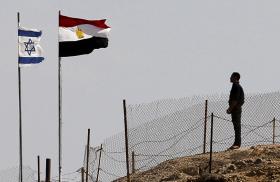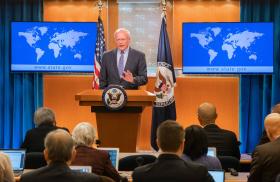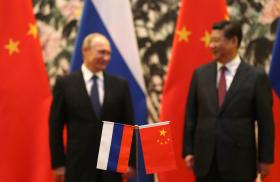
- Policy Analysis
- Articles & Op-Eds
UAE President’s White House Visit Is About Much More Than Mere Formalities
Also published in The National

Besides strengthening both countries’ economies, the visit represents a new model of international partnership where traditional alliances intersect with cutting-edge innovation.
This week, history will be made as President Sheikh Mohamed steps onto the White House lawn. Not only will he become the first sitting UAE President to receive the recognition of a state visit to the American presidential residence, he will also be paving the way for a new chapter in US-Middle East relations. What began as alliances forged in the desert have now evolved into collaborations that extend to space exploration, cutting-edge technology and high-stakes diplomacy.
This landmark visit, featuring key meetings with US President Joe Biden, Vice President Kamala Harris, and top congressional leaders, signifies much more than mere formalities. It is a powerful testament to how far the UAE-US partnership has come and how vital it is to the future of both nations. As the UAE solidifies its role as a pivotal player in the region, this visit underscores the deepening bonds between the two countries—a relationship that is growing ever more robust since the signing of the Abraham Accords in 2020.
The Abraham Accords did not just establish relations between Israel and several Arab states, including the UAE; they supercharged the geopolitical landscape of the Middle East. The Emirates emerged from these agreements as a crucial regional mediator and a strategic partner to the US. Sheikh Mohamed’s visit highlights the acceleration of this relationship, with US-UAE ties now reaching new heights, driven by shared interests and mutual goals.
Yet, as the UAE strengthens its global position, it also faces the complex realities of regional conflict. As the Gaza crisis drags on with no clear resolution in sight, the UAE has taken on a significant humanitarian role, providing aid and support to those affected. By hosting nearly 2,000 wounded and sick Palestinians from Gaza and their families, and delivering essential supplies, the UAE’s humanitarian efforts demonstrate its commitment to alleviating suffering.
Six newly established desalination plants and two field hospitals treating thousands of patients underscore the scale of the UAE’s response. At the same time, the UAE has also made it clear that there will be no support for post-war reconstruction without meaningful progress toward a Palestinian state. This firm position echoes growing regional frustration over the stagnant peace process.
On the economic front, the US and UAE are deeply intertwined. According to official figures, bilateral trade surged to more than $31 billion last year, with US exports to the UAE jumping 19 per cent, supporting approximately 166,000 American jobs. The first half of this year has already witnessed trade hit $16.9 billion, a trend that shows no signs of slowing. As partners in the global economy, the two countries have become preferred customers in each other’s markets, with billions of dollars flowing both ways.
The UAE’s investments in the US are equally impressive. Mubadala Investment Company, one of the UAE’s sovereign wealth funds, has directed more than $100 billion into US ventures. These investments are reshaping industries, from finance to technology, establishing the UAE as a bridge between the US and the broader Middle East.
Nowhere is the partnership more apparent than in the realm of technology. From Silicon Valley to the Gulf, the US and the Emirates are building the future together. Microsoft’s $1.5 billion investment in Emirati AI company G42 is only the beginning, as the company continues to form partnerships with tech giants like Nvidia and Cerebras. Their joint $1 billion digital investment in Kenya exemplifies how US-UAE tech collaboration is extending its transformative reach into Africa. The prospects of bilateral partnerships between American and Emirati firms globally are far-reaching.
In the energy sector, the collaboration between the US and UAE is undergoing a transformation. What began as traditional oil deals have now expanded into pioneering renewable energy projects. Masdar, the UAE’s renewable energy leader, is making significant inroads into the US market, while the national oil company, Adnoc, is diversifying its portfolio with investments in American energy projects, including the burgeoning hydrogen sector in Texas. The sight of Gulf states investing in hydrogen reflects a paradigm shift in how Gulf-American partnerships are evolving.
The aerospace industry provides another striking example of the relationship’s scale. The Emirates Group’s recent order for 95 additional Boeing aircraft worth $52 billion will support thousands of jobs in the American aerospace sector. This monumental deal exemplifies how the partnership between the UAE and US transcends industries, fostering economic growth and innovation on both sides.
In healthcare, the collaboration is equally transformative. The UAE is tapping into American expertise to build state-of-the-art medical facilities, benefiting patients from Baltimore to Bahrain. Notably, PureHealth’s $490 million investment in Ardent Health Services highlights the growing ties in the health sector, while joint ventures are reshaping healthcare delivery in both nations.
Climate co-operation is yet another cornerstone of this evolving relationship. The Partnership for Accelerating Clean Energy between the US and UAE aims to mobilise $100 billion in clean energy investments, advancing shared goals in climate action while balancing energy security and economic growth.
On the defence front, the UAE’s partnership with the US runs deep. Emirati forces have stood alongside American troops on battlefields from Afghanistan to Iraq, demonstrating their commitment to global security. The UAE has also been a key ally in the fight against ISIS and Al Qaeda, playing an expeditionary role in the Global Coalition to Defeat ISIS. This co-operation in counterterrorism has cemented the UAE’s status as one of America’s most dependable military allies in the region.
As Sheikh Mohamed prepares for his historic state visit, expectations are high. New announcements are anticipated in areas ranging from high-tech co-operation, joint investments and other partnerships that could further strengthen both economies. But more than that, this visit represents a blueprint for the future—a new model of international partnership where traditional alliances intersect with cutting-edge innovation. The outcomes of this visit could reshape diplomatic, economic and technological landscapes, further cementing the UAE’s role as a key ally in the Middle East and a critical player in global economic growth.
In this US-UAE dance, both nations are leading, with each step revealing new opportunities. The partnership has transformed from oil barrels to silicon chips, from desert patrols to space stations—a journey as dramatic as the UAE’s own rise. As the world watches Sheikh Mohamed’s visit unfold, it’s clear that he’s not just making history—he’s helping to write the future of US-Middle East relations.
Nickolay Mladenov is the Segal Distinguished Visiting Fellow at The Washington Institute and former UN special coordinator for the Middle East peace process. This article was originally published on The National website.



